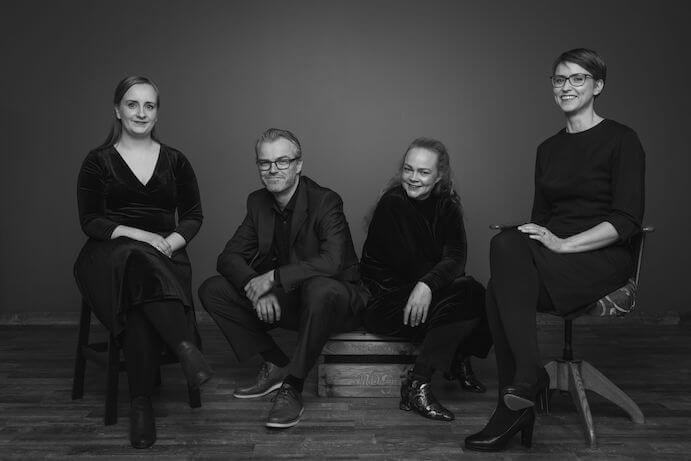Picturesque Northern Lights, innumerable mountains and volcanoes, otherworldly waterfalls. Musicians who have received international acclaim for their distinctive sounds, including the likes of Björk, Sigur Rós, and Of Monsters and Men. With their new album South of the Circle (Sono Luminus), the Reykjavik-based Siggi String Quartet (Sigurður Bjarki Gunnarsson, cello; Una Sveinbjarnardóttir, Helga Þóra Björgvinsdóttir, violins; Þórunn Ósk Marínósdóttir, viola) digs into their roots, presenting five works by Icelandic composers that get to the heart of the music and the terrain that characterize the Nordic nation.
Valgeir Sigurðsson’s Nebraska Quartet (2011) reflects on the natural landscapes of Iceland, comparing them with those of Nebraska. In i. “Flat Water,” tremolo in the upper voices and a bouncing cello line create a feeling of excitement and adventure. A sudden shift to motionless lower voices is layered with a repeating angular, leaping melody in the violins, which is eventually played in unison by the quartet. The more static moments embody the calm steadiness of flat water; the repeating motif in the end evokes the ever-present motion of the many rivers and streams of both Iceland and Nebraska

In Fair Flowers (2018), composer Mamiko Dís Ragnarsdóttir uses a system of colors to capture the nature of Northern Iceland and the Trollaskagi Peninsula as depicted in a painting by Eggert Pétursson entitled “Án titils” (no title) (2011). The mood shifts unpredictably throughout the piece, likely due to its color-based process; one moment we sit in a heavy texture with plodding motion in individual voices, and the next, jaunty melodies wind around each other. To better understand the full brilliance of this piece, it would be helpful to know more about the color system; did Mamiko go inch by inch, composing colors in order? Or does the work broadly reflect how the painting’s colors interact with one another? While the resulting sounds are lush, it is difficult to imagine how the piece relates to Eggert’s painting of Northern Iceland.
The remaining three pieces on South of the Circle explore the breadth of language available to a string quartet. Haukur Tómasson’s Serimonia (2014) is intentionally aware of this exploration, following a rigid form in which five textures are presented and then repeated in varying orders. The resulting piece highlights a variety of techniques and tones: one section features metallic strumming and plucking; another focuses on legato, arco playing in a sort of call and response; another plays with sharp, pointed sounds, with short and cutting attacks by all four voices.
Stillshot (2015), composed by Daníel Bjarnason, also uses a broad array of sounds to depict what Daníel describes as the fragmented memories of a noblewoman. Jagged passages fall into moments of repose, and then lift back up again. Strings slap, and are followed by silence. The texture becomes static, with light rumbling from the cello and slow changes in the upper voices, until blips of sound and texture burst through: sometimes low and vibrating, other times high and percussive. These explosive moments are often punctuated by silence, giving the sense that we are literally exiting one moment, one memory, and entering another. It’s as if the listener is being allowed short glimpses of this noblewoman’s memories while riding in a particularly erratic tour bus.

The standout on South of the Circle is Opacity (2014), composed by Una Sveinbjarnardóttir (also first violinist for the quartet). Consisting of four movement-long solos for each member of the ensemble, the work showcases each player with writing that highlights each instrument’s strengths. Opacity’s final movement, “Less,” which features the composer herself, begins by following a rather simple format: Una plays a minor second interval, which is followed by a short, jumpy reaction from the rest of the quartet. This gesture is then repeated and transposed, and with each repetition, the listener develops an expectation of what they’ll hear; that is, until the movement begins to unravel.
As the piece goes on, the first violin plays microtonal intervals, not quite the half step we’ve grown accustomed to. The response from the three lower voices becomes dissonant, not unified as it was at the start. There are rogue reactions from the lower voices, not signaled by the first violin. “Less” is all about forming and then thwarting listeners’ expectations, getting them to lean into the sound and wonder if each iteration will resolve in the way they predict. The movement is rewarding when it meets our predictions, and stimulating when it doesn’t.
For those who have not yet had the chance to delve deep into the repertoire of living Icelandic composers, South of the Circle goes far past a basic introduction, presenting an impressive range of sounds, techniques, and imagery. It will be exciting to see how this relatively young quartet will continue to combine its Icelandic roots with its passion for interpreting new and standard repertoire.
























